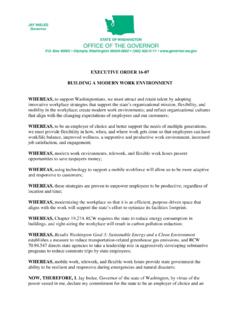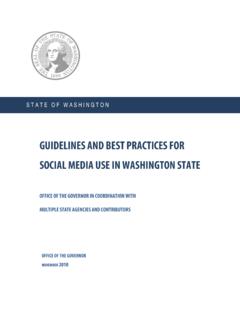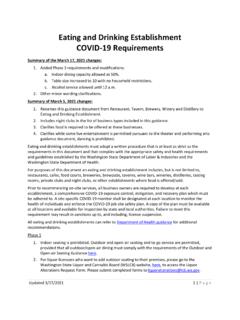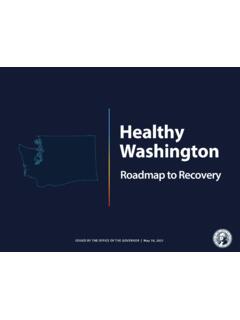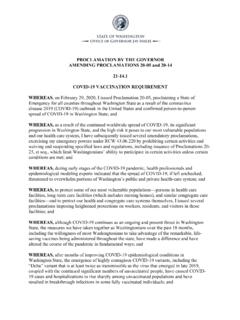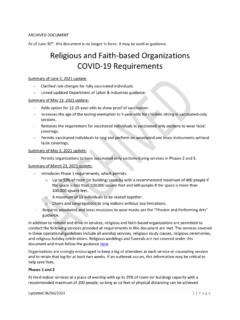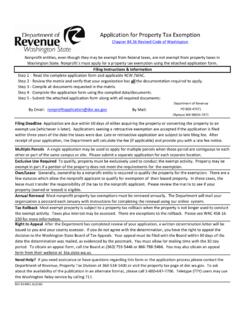Transcription of HEALTHCARE / PUBLIC HEALTH - Wa
1 March 23, 2020. Proclamation 20-25. Appendix On March 23, 2020, Governor Inslee issued Proclamation directing all residents immediately to heed current State PUBLIC HEALTH directives to stay home, except as needed to maintain continuity of operations of essential critical infrastructure sectors and additional sectors as the State PUBLIC HEALTH Officer may designate as critical to protect HEALTH and well-being of all Washingtonians. In accordance with this Proclamation, the Governor has designated the following list of Essential Critical Infrastructure Workers to help state, local, tribal, and industry partners as they work to protect communities, while ensuring continuity of functions critical to PUBLIC HEALTH and safety, as well as economic and national security. HEALTHCARE / PUBLIC HEALTH . Sector Profile The HEALTHCARE and PUBLIC HEALTH (HPH) Sector is large, diverse, and open, spanning both the PUBLIC and private sectors.
2 It includes publicly accessible HEALTHCARE facilities, research centers, suppliers, manufacturers, and other physical assets and vast, complex PUBLIC -private information technology systems required for care delivery and to support the rapid, secure transmission and storage of large amounts of HPH data. Essential Workforce Workers providing COVID-19 testing and workers that perform critical clinical research and development needed for COVID-19 response. HEALTH care providers and caregivers ( , physicians, dentists, psychologists, mid-level practitioners, nurses and assistants, infection control and quality assurance personnel, pharmacists, physical and occupational therapists and assistants, midwives and doulas attending facility-based or home-based births, alternative HEALTHCARE providers, social workers, speech pathologists and diagnostic and therapeutic technicians and technologists).
3 Hospital and laboratory personnel (including accounting, administrative, admitting and discharge, engineering, epidemiological, source plasma and blood donation , food service, housekeeping, medical records, information technology and operational technology, nutritionists, sanitarians, respiratory therapists, etc.). Workers in other medical facilities (including Ambulatory HEALTH and Surgical, Blood Banks, Clinics, Community Mental HEALTH , Comprehensive Outpatient rehabilitation, End Stage Renal Disease, HEALTH Departments, Home HEALTH care, Hospices, Hospitals, Long Term Care, Organ Pharmacies, Procurement Organizations, Psychiatric, Residential, Rural HEALTH Clinics and Federally Qualified HEALTH Centers, biotechnology therapies, consumer HEALTH products, cannabis retailers). Manufacturers, technicians, logistics and warehouse operators, and distributors of medical equipment, medical devices, diagnostics, personal protective equipment (PPE), medical gases, pharmaceuticals, blood and blood products, vaccines, testing materials, laboratory supplies, cleaning, sanitizing, disinfecting or sterilization supplies, and tissue and paper towel products.
4 1. March 23, 2020. Proclamation 20-25. Appendix PUBLIC HEALTH / community HEALTH workers, including those who compile, model, analyze and communicate PUBLIC HEALTH information. Behavioral HEALTH workers (including mental and substance use disorder) responsible for coordination, outreach, engagement, and treatment to individuals in need of mental HEALTH and/or substance use disorder services. Blood and plasma donors and the employees of the organizations that operate and manage related activities. Workers that manage HEALTH plans, billing, and HEALTH information, who cannot practically work remotely. Workers who conduct community-based PUBLIC HEALTH functions, conducting epidemiologic surveillance, compiling, analyzing and communicating PUBLIC HEALTH information, who cannot practically work remotely. Workers who provide support to vulnerable populations to ensure their HEALTH and well-being including family care providers Workers performing cybersecurity functions at HEALTHCARE and PUBLIC HEALTH facilities, who cannot practically work remotely.
5 Workers conducting research critical to COVID-19 response. Workers performing security, incident management, and emergency operations functions at or on behalf of HEALTHCARE entities including HEALTHCARE coalitions, who cannot practically work remotely. Workers who support food, shelter, and social services, and other necessities of life for economically disadvantaged or otherwise needy individuals, such as those residing in shelters. Pharmacy employees necessary for filling prescriptions. Workers performing mortuary services, including funeral homes, crematoriums, and cemetery workers. Workers who coordinate with other organizations to ensure the proper recovery, handling, identification, transportation, tracking, storage, and disposal of human remains and personal effects; certify cause of death; and facilitate access to behavioral HEALTH services to the family members, responders, and survivors of an incident.
6 Workers supporting veterinary hospitals and clinics EMERGENCY SERVICES SECTOR. Sector Profile The Emergency Services Sector (ESS) is a community of highly-skilled, trained personnel, along with the physical and cyber resources, that provide a wide range of prevention, preparedness, response, and recovery services during both day-to-day operations and incident response. The ESS includes geographically distributed facilities and equipment in both paid and volunteer capacities organized primarily at the federal, state, local, tribal, and territorial levels of government, such as city police departments and fire stations, county sheriff's offices, Department of Defense police and fire departments, and town PUBLIC works departments. The ESS also includes private sector resources, such as industrial fire departments, private security organizations, and private emergency medical services providers.
7 2. March 23, 2020. Proclamation 20-25. Appendix Essential Workforce - Law Enforcement, PUBLIC Safety and First Responders Including front line and management, personnel include emergency management, law enforcement, Emergency Management Systems, fire, and corrections, search and rescue, tactical teams including maritime, aviation, and canine units. Military personnel, including National Guard personnel and Coast Guard personnel Emergency Medical Technicians PUBLIC Safety Answering Points and 911 call center employees Fusion Center employees Fire Mitigation Activities Hazardous material responders and hazardous devices teams, from government and the private sector. Workers including contracted vendors -- who maintain digital systems infrastructure supporting law enforcement and emergency service operations. Private security, private fire departments, and private emergency medical services personnel.
8 Protective services workers responsible for mission critical functions in state institutions, programs, and community facilities, including homeless shelters. Essential Workforce - PUBLIC Works Workers who support the operation, inspection, and maintenance of essential dams, locks and levees Workers who support the operation, inspection, and maintenance of essential PUBLIC works facilities and operations, including bridges, water and sewer main breaks, fleet maintenance personnel, construction of critical or strategic infrastructure, traffic signal maintenance, emergency location services for buried utilities, maintenance of digital systems infrastructure supporting PUBLIC works operations, and other emergent issues Workers such as plumbers, electricians, exterminators, and other service providers who provide services that are necessary to maintaining the safety, sanitation, and essential operation of residences.
9 Support, such as road and line clearing, to ensure the availability of needed facilities, transportation, energy and communications. Support to ensure the effective removal, storage, and disposal of residential and commercial solid waste and hazardous waste. FOOD AND AGRICULTURE. Sector Profile The Food and Agricultural (FA) Sector is composed of complex production, processing, and delivery systems and has the capacity to feed people and animals both within and beyond the boundaries of the United States. Beyond domestic food production, the FA Sector also imports many ingredients and finished products, leading to a complex web of growers, processors, suppliers, transporters, distributors, and consumers. This sectors is critical to maintaining and securing our food supply. 3. March 23, 2020. Proclamation 20-25.
10 Appendix Essential Workforce Workers supporting groceries, pharmacies, and other retail that sells food and beverage products, including but not limited to Grocery stores, Corner stores and convenience stores, including liquor stores that sell food, Farmers' markets, Food banks, Farm and produce stands, Supermarkets, Similar food retail establishments, Big box stores that sell groceries and essentials. Restaurant carry-out and quick serve food operations including food preparation, carry-out and delivery food employees Food manufacturer employees and their supplier employees to include those employed in food processing (packers, meat processing, cheese plants, milk plants, produce, etc.) facilities; livestock, poultry, seafood slaughter facilities; pet and animal feed processing facilities; human food facilities producing by-products for animal food; beverage production facilities; shellfish facilities including hatcheries and nurseries and growing areas; brewery and wine-making facilities; coffee production facilities; artisan food production; and the production of food packaging Farm workers to include those employed in animal food, feed, and ingredient production, packaging, and distribution; manufacturing, packaging, and distribution of veterinary drugs; truck delivery and transport; farm and fishery labor needed to produce our food supply domestically Farm workers and support service workers to include those who field crops; commodity inspection.
